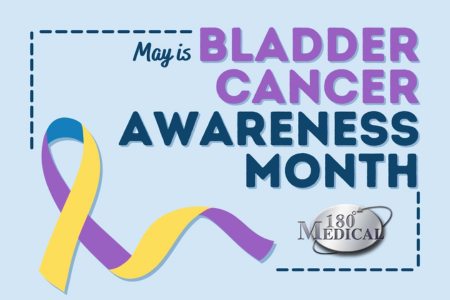
May is Bladder Cancer Awareness Month, a time to spread awareness about one of the most common urologic cancers today. Bladder cancer is a common form of cancer that can afflict anyone. Let’s go over the info you need to know about bladder cancer symptoms and risk factors.
Bladder cancer is a common form of cancer, with thousands diagnosed each year. Understanding its risk factors, recognizing symptoms early, and knowing what life might look like after treatment can help those who may face this diagnosis. Let’s explore what you need to know about bladder cancer, its symptoms, risk factors, and options for living well after treatment.
What is Bladder Cancer?
Bladder cancer is a common form of cancer, with thousands diagnosed each year. Bladder cancer happens when the cells in the bladder’s inner layers begin to divide and grow without stopping. When left untreated, it can grow out of control and spread to the lining of the kidneys, ureters, and urethra.

What are the Symptoms of Bladder Cancer?
Recognizing the early signs of bladder cancer may make a big difference in treatment outcomes. Keep an eye out for common bladder cancer systems, which may include:
- Blood in the urine that may appear intermittently
- Irritation, pain, or burning during urination
- More frequent urge to urinate
- Pelvic discomfort
- Unexplained lower back pain
However, it’s important to remember that these symptoms don’t always add up to cancer. For example, blood in urine, burning or pain during urination, and increased urgency may actually be signs of a urinary tract infection.
Talk to your primary healthcare provider or your urologist, especially if you notice any changes or symptoms like these.
FAQ: Is blood in urine always a sign of bladder cancer?
No, not necessarily. Blood in urine (also known as hematuria) can also indicate a urinary tract infection (UTI) or kidney stones or something else entirely. Talk to your healthcare provider to rule out serious conditions.
Video Source: Bladder Cancer Advocacy Network
What Causes Bladder Cancer? Common Risk Factors
Bladder cancer can happen to anyone, although certain demographics may be at a higher risk. According to the American Cancer Society, recent statistics indicate “about 80,470 new cases of bladder cancer (about 61,700 in men and 17,770 in women).” So it appears that men may be more likely than women to develop bladder cancer.
Exposure to chemicals long-term are a potential risk factor, like pollutants in drinking water or hair dye. People in certain professions, like painters, hairdressers, rubber workers, and textile or metal workers, may face higher risks due to exposure to certain industrial chemicals.
Chronic bladder inflammation from bladder infections or stones may play a part in the development of bladder cancer too.
Surprisingly, the top risk factor is smoking cigarettes. In addition, e-cigarettes or vapes may be linked with bladder cancer. If you use nicotine, consider quitting to lower your risk. Five years after quitting smoking or using tobacco products, your risk of bladder cancer may be cut in half!
Common risk Factors for bladder cancer may include:
- Tobacco or nicotine use (smoking, vaping, dipping, etc.)
- Chronic bladder irritation from causes like bladder stones, frequent UTIs, or indwelling Foley catheter use)
- Chemical exposure
- Age and gender
- Previous cancer treatment (Those who have had certain chemotherapy drugs or radiation therapy to the pelvic area may have an increased risk)
While these factors can increase the likelihood of developing bladder cancer, it’s important to remember that having one or more risk factors doesn’t mean you’ll develop the condition.
Diagnosing and Treating Bladder Cancer
Bladder cancer is typically diagnosed through:
- Urine tests
- Imaging studies like CT scans or ultrasound
- Cystoscopy, which involves examining the inside of your bladder with a small camera
Once diagnosed, your healthcare provider will determine the cancer’s stage and recommend the appropriate treatment, which may include surgery, chemotherapy, radiation, immunotherapy, or a combination of these treatments.
In certain advanced cases, a cystectomy (complete bladder removal) may be required.
What Happens If I Need My Bladder Removed?
If caught early, bladder cancer is treatable, and many people go on to live fulfilling lives. For some, treatment may involve the removal of the bladder, called a cystectomy, as part of the effort to prevent cancer from spreading.
When the bladder is removed, urine must be rerouted from the body. There are a couple of options:
1. Urostomy Surgery
A urostomy creates a new way for urine to leave your body. During this surgery, a small piece of the intestine is used to connect the ureters to a stoma (an opening on the abdomen). The urine then flows into an external urostomy pouch worn on the body.
Life with a urostomy requires some adjustment, but many people adapt well over time. Proper care and choosing the right supplies can help you maintain an active lifestyle.
2. Neobladder Reconstruction:
For some, a neobladder is created from a section of the intestine and connected to the urethra, allowing for more typical urination. This option may allow for greater independence, but it may also require intermittent catheterization to fully empty the bladder.
FAQ: What’s the difference between a urostomy and a neobladder?
A urostomy uses an external pouch that can be changed out and emptied. A neobladder is internal, but may require catheterization to empty it regular, like a normal bladder.
Living Well with a Urostomy or Neobladder
Adapting to life after bladder cancer surgery is about learning to manage your new urinary system effectively. If you’ve undergone urostomy surgery, choosing high-quality supplies can improve comfort and ease of use.
At 180 Medical, we provide a range of products to support your needs, including intermittent catheters, urostomy pouches, and other ostomy products. Contact us today to explore your insurance-covered urostomy options. We’ll gladly help you find the right supplies for your needs.
